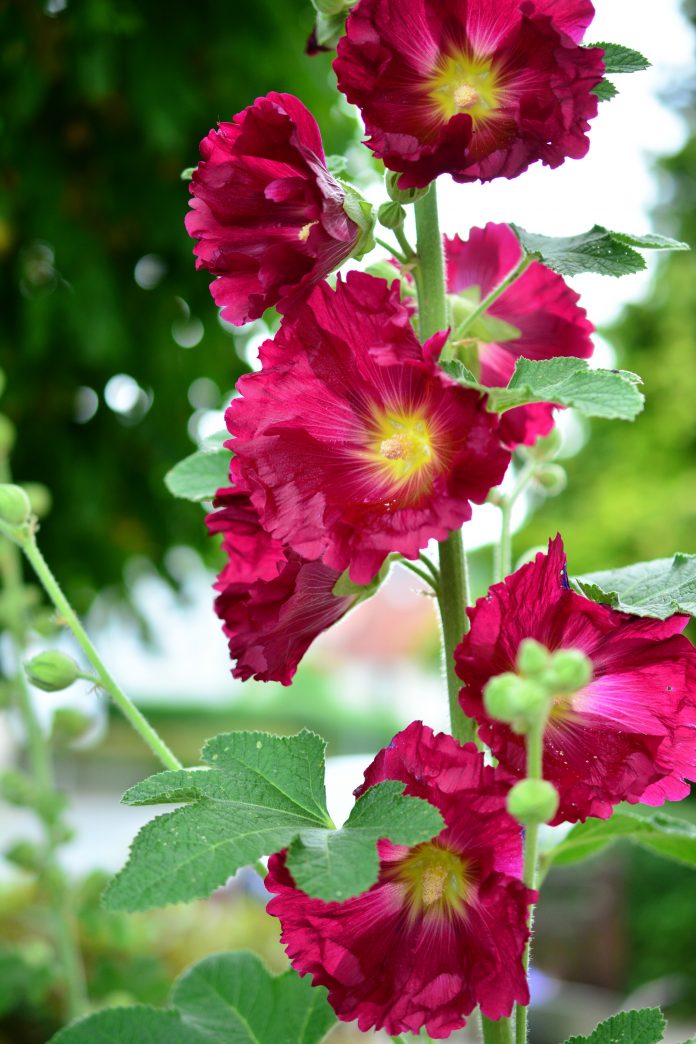
The hollyhock is a bright flowering plant in most farm gardens. Above man’s height it stretches into the sky and bears whole flocks of large, red flowers. Because of its attractive flowers, the hollyhock is a bright ornament in gardens.
Like its relatives from the mallow family, the hollyhock helps against coughing and other respiratory diseases. It can also be helpful for skin problems.
Plant description
Originally, the hollyhock comes from south-eastern Europe, but it has been native to most farm gardens for a long time. The biennial to perennial plant has large, lobed leaves near the ground, which sit on long stems. The leaves are slightly hairy.
From the second year onwards, the hollyhock grows a flower stalk that can grow to over two metres high. The large flowers grow on this stem in the leaf axils in midsummer. Originally they were black-red, but there are now cultivars in almost all shades of red.
Because the flowers can be so heavy, most hollyhocks need a stick to support them. It is possible that this is where the name hollyhock comes from. Or because the flowers grow like on a stick.
Characteristics
Scientific name
Althaea rosea.
Plant family
Malvaceae.
Other name
Commun Hollyhock.
Used plant parts
Flower, leaf & root.
Ingredients
Mucilage, anthocyanin, tannic acid, red dye, essential oils.
Harvest period
July and August.
Medicinal properties
As a relative of marshmallow, mallow and hibiscus, it also has similar healing properties to these. Its mucus is considered to be particularly important. This makes it a valued medicinal plant for diseases of the respiratory system. But also skin and digestive organs can benefit from it.
Main uses: Respiratory system & Skin.
Healing effects
- Cold
- Bronchitis
- Cough
- Fever
- Inflammation
- Eczema
- Skin irritation
- Wounds
- Burns (minor)
- Ulcers
- Softening
- Diuretic
- Antispasmodic
- Loss of appetite
- Mouth sores
- Pharyngitis
- Sore throat
- Vocal chord inflammation
- Stomach inflammation
- Bowel inflammation
- Diarrhea
- Menstruation promoting
- Vaginal discharge
Application methods
- Orally
- Topically
Forms of preparation
Mainly the flowers of the hollyhock are used as a remedy. But leaves, roots and seeds also have healing powers. The hollyhock tea helps against coughs and sore throats. It can also be used for gargling.
Internal uses
It is better to prepare the tea from the hollyhock blossoms as a cold extract to preserve the mucilage they contain. If the hollyhock flowers are a component of tea mixtures, which is often the case for optical reasons, they can also be prepared as an infusion.
The root of the hollyhock is used in a similar way to the flowers, as it also contains mucilage and tanning agents. It is used against diarrhoea and other digestive tract complaints as well as loss of appetite.
Seeds tea
The seeds can be used against fever. They also have a diuretic and enveloping effect.
External uses
Externally, hollyhock tea can be used as a wash or compress for various skin problems. The hollyhock tea has both a softening and astringent effect. Thus it can soothe inflammations and promote the healing of wounds. As a sitz bath one can use the hollyhock tea against vaginal discharge.
English
Etymology
From Middle English holihocke, holyhokke, holihoc, from holi (“holy”) + hocke, hokke, hoc (“mallow”) (from Old English hoc (“marsh mallow”). The modern hollyhock was probably unknown in England until the 15th century, so usage before then no doubt referred to some other mallow.
Pronunciation
Noun
hollyhock (plural hollyhocks)
- Any of several flowering





